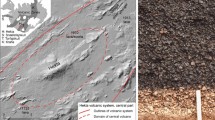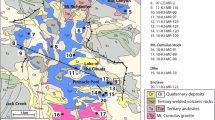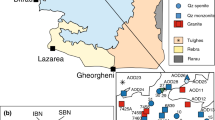Abstract
The isotopic compositions of Nd and Sr and concentrations of major and trace elements were measured in flows and tuffs of the Woods Mountains volcanic center of eastern California to assess the relative roles of mantle versus crustal magma sources and of fractional crystallization in the evolution of silicic magmatic systems. This site was chosen because the contrast in isotopic composition between Precambrian-to-Mesozoic country rocks and the underlying mantle make the isotope ratios sensitive indicators of the proportions of crustal- and mantle-derived magma. The major eruptive unit is the Wild Horse Mesa tuff (15.8 m.y. old), a compositionally zoned rhyolite ignimbrite. Trachyte pumice fragments in the ash-flow deposits provide information on intermediate composition magma types. Crustal xenoliths and younger flows of basalt and andesite (10 m.y. old) provide opportunities to confirm the isotopic compositions of potential mantle and crustal magma sources inferred from regional patterns. The trachyte and rhyolite have ɛNd values of -6.2 to -7.5 and initial 87Sr/86Sr ratios mostly between 0.7086 and 0.7113. These magmas cannot have been melted directly from the continental basement because the ɛNd values are too high. They also cannot have formed by closed system fractional crystallization of basalt because the 87Sr/86Sr ratios are higher than likely values for parental basalt. Both major and trace element variations indicate that crystal fractionation was an important process. These results require that the silicic magmas are end products of the evolution of mantle-derived basalt that underwent extensive fractional crystallization accompanied by assimilation of crustal rock. The mass fraction of crustal components in the trachyte and rhyolite is estimated to be between 10% and 40%, with the lower end of the range considered more likely. The generation of magmas with SiO2 contents greater than 60% appears to be dominated by crystal fractionation with minimal assimilation of upper crustal rocks.
Similar content being viewed by others
References
Barker F (1981) Introduction to special issue on granites and rhyolites: A commentary for the nonspecialist: J Geophys Res 86:10131–10135
Beckerman GM, Robinson JP, Anderson JL (1982) The Teutonia batholith: a large intrusive complex of Jurassic and Cretaceous age in the eastern Mojave Desert, California. In: Frost EG, Martin DL (eds) Mesozoic-Cenozoic tectonic evolution of the Colorado River Region, California, Arizona and Nevada. Cordilleran Publishers, San Diego, pp 205–220
Bennett VC, DePaolo DJ (1987) Proterozoic crustal history of the western United States as determined by Neodymium isotopic mapping. Geol Soc Am Bull 99:674–685
Bryan WB, Finger LW, Chayes F (1969) Estimating proportions in petrographic mixing equations by least-squares approximation: Science 143:926–927
Cameron KL (1984) Bishop Tuff revisited: New rare earth element data consistent with crystal fractionation. Science 224:1338–1340
Christiansen ER (1983) The Bishop tuff revisited: Compositional zonation by double diffusive fractional crystallization (DDFC). Geol Soc Am Abstr Prog 15 (5): 39
Christiansen RL, Lipman P (1972) Cenozoic volcanism and platetectonic evolution of the western United States — Part II, Late Cenozoic: Phil Trans R Soc London A 271:249–284
DePaolo DJ (1981a) Trace element and isotopic effects of combined wallrock assimilation and fractional crystallization. Earth Planet Sci Lett 53:189–202
DePaolo DJ (1981b) A neodymium and strontium isotopic study of the Mesozoic calc-alkaline granitic batholiths of the Sierra Nevada and Peninsular Ranges, California. J Geophys Res 86: B11:10470–10488
DePaolo DJ, Wasserburg GJ (1976) Inferences about magma sources and mantle structure from variations of 143Nd/144Nd: Geophys Res Lett 4:465–468
Fabbi BP (1972) A refined fusion x-ray fluorescence technique and determination of major and minor elements in silicate standards. Am Mineral 57:237–245
Farmer GL (1986) A Sm-Nd isotopic study of Precambrian sedimentary provenance in the Great Basin, western US. Terra Cognita 6:238
Farmer GL, DePaolo DJ (1983) Origin of Mesozoic and Tertiary granite in the western United States and implications for pre- Mesozoic Crustal Structure. 1. Nd and Sr isotopic studies in the northern Great Basin. J Geophys Res 88:3379–3401
Farmer GL, DePaolo DJ (1984) Origin of Mesozoic and Tertiary granite in the western US and implications for pre-Mesozoic crustal structure. 2. Nd and Sr isotopic studies of unmineralized and Cu-and Mo-mineralized granite in the Precambrian craton. J Geophys Res 89:10141–10160
Glazner AF (1988) Stratigraphy, structure, and potassic alteration of Miocene volcanic rocks in the Sleeping Beauty area, central Mojave Desert, California. Geol Soc Am Bull 100:424–435
Grove TL, Gerlach DC, Sando TW (1982) Origin of calc-alkaline lavas at Medicine Lake volcano by fractionation, assimilation and mixing. Contrib Mineral Petrol 80:160–182
Hildreth W (1979) The Bishop tuff: evidence for the origin of compositional zonation in silicic magma chambers. Geol Soc Am Spec Pap 180:43–75
Hildreth W (1981) Gradients in silicic magma chambers: implications for lithospheric magmatism: J Geophys Res 86:10153–10192
Jaffee HW, Gottfried D, Waring CL, Worthing HW (1959) Leadalpha age determination of accessory minerals of igneous rocks (1953–1957). US Geol Surv Bull 1097B, pp 148
Kay RW, Kay SM (1980) Chemistry of the lower crust: inferences from magmas and xenoliths. Continental tectonics. Natl Acad Sci, Washington, DC, pp 139–150
Le Bas MJ, Le Maitre RW, Streckeisen A, Zanettin B (1986) A chemical classification of volcanic rocks based on the total alkali — silica diagram. J Petrol 27:745–750
McBirney AR (1980) Mixing and unmixing of magmas. J Volcanol Geotherm Res 86:10153–10192
McCurry M (1982) The geology of a late Miocene silicic volcanic center in the Woods and Hackberry Mountains area of the eastern Mojave Desert, San Bernardino County, California. In: Frost EG, Martin DL (eds) Mesozoic-Cenozoic tectonic evolution of the Colorado River region, California Arizona and Nevada. Cordilleran Publishers, San Diego, pp 433–439
McCurry M (1985) The petrology of the Woods Mountains volcanic center, San Bernardino County, California. Ph D Dissertation, Univ of California, Los Angeles, pp 403
McCurry M (1988) Geology and petrology of the Woods Mountains volcanic center, southeastern California: implications for the genesis of peralkaline rhyolite ash flow tuffs: J Geophys Res (in press)
Menzies MA, Leeman WP, Hawkesworth CJ (1983) Isotope geochemistry of Cenozoic volcanic rocks reveals mantle heterogeneity below western USA. Nature 303:205–209
Michael PJ (1983) Chemical differentiation of the Bishof Tuff and other high silica magma chambers through crystallization processes. Geology 11:31–34
Myers JD, Marsh BD (1981) Geology and petrogenesis of the Edgecumbe volcanic field, SE Alaska: The interaction of basalt and sialic crust. Contrib Mineral Petrol 77:272–287
Myers JD, Sinha AK, Marsh BD (1984) Assimilation of crustal material by basaltic magma: Strontium isotopic and trace element data from the Edgecumbe volcanic field, SE Alaska. J Petrol 25:1–26
Noble DC (1967) Sodium, potassium, and iron contents of some secondarily hydrated natural silicic glasses. Am Mineral 52:280–286
Perry FV, DePaolo DJ, Baldridge WS (1983) Nd and Sr isotopic evidence for the origin of Mt Taylor lavas and depleted mantle beneath the Colorado Plateau-Rio Grande Rift, Central New Mexico. EOS 64:753
Perry FV, Baldridge WS, DePaolo DJ (1987) The role of asthenosphere and lithosphere in the genesis of Late Cenozoic basaltic rocks from the Rio Grande rift and adjacent regions of the southwestern United States. J Geophys Res 92:9193–9213
Perry FV, Baldridge WS, DePaolo DJ (1988) Chemical and isotopic evidence for lithospheric thinning beneath the Rio Grande rift. Nature 332:432–434
Semken SC (1984) A neodymium and strontium isotopic study of late Cenozoic basaltic volcanism in the southwestern Basin and Range province. MS thesis, Univ of California, Los Angeles, pp 68
Shaw HR (1965) Comments on viscosity, crystal settling and convection in granitic magmas. Am J Sci 263:120–152
Shaw HR (1980) The fracture mechanisms of magma transport from the mantle to the surface. In: Hargrave RB (ed) Physics of magmatic processes. Princeton University Press, Princeton, pp 201–264
Author information
Authors and Affiliations
Rights and permissions
About this article
Cite this article
Musselwhite, D.S., DePaolo, D.J. & McCurry, M. The evolution of a silicic magma system: isotopic and chemical evidence from the Woods Mountains volcanic center, eastern California. Contr. Mineral. and Petrol. 101, 19–29 (1989). https://doi.org/10.1007/BF00387198
Received:
Accepted:
Issue Date:
DOI: https://doi.org/10.1007/BF00387198




